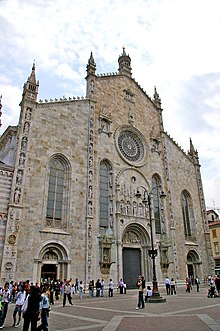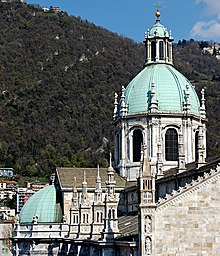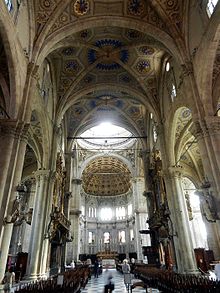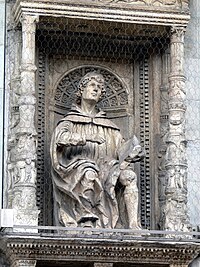Como Cathedral
The Cathedral of Como (Italian: Cattedrale di Santa Maria Assunta , also Duomo di Como ) is the cathedral of the Diocese of Como . It is in the old town of Como , Via Maestri Comacini, 4. The cathedral was the last of the Gothic cathedrals to be built in Lombardy . Construction began in 1396, around ten years after the foundation stone of the Milan Cathedral was laid , and lasted about three and a half centuries. During this time, numerous architectural styles were incorporated into the cathedral. The dominant architectural style has remained the original late Gothic or early Renaissance style. The cathedral houses an important painting of St. Joseph by Giambattista Pittoni .
history
Already before 1396 there was a cathedral in Como, not far from the lake, which was dedicated to "Santa Maria Maggiore" and was built in the 9th century. At the end of the 14th century, it was decided to build a new one instead of restoring the old cathedral. The architect Lorenzo degli Spazzi (Laino D'Intelvi) was responsible for its planning.
From 1426 the construction was taken over by the architect Pietro da Breggia, who had a significant influence on the design, and from 1457 the architects Florio da Bontà and Lichino Scarabota. In the course of the construction work on the new cathedral, the old cathedral church, which was initially close to the new building, was largely demolished; Only remains are preserved, especially the southern wall. The side wing of the cathedral was built between 1487 and 1513. The main apse and sacristy were built between 1513 and 1519. The southern and northern apses were built at the beginning and the middle of the 17th century. The dome was built between 1731 and 1744 according to plans by Filippo Juvara, the architect of the Sardinian king. Construction work ended in 1774.

The cathedral is a total of 87 m long; The first two bays have been shortened to allow the nave to be flush with the facade of the Broletto . The dome reaches a height of 75 m, the facade a height of 45 m. The naves are 58 m wide.
Pope Pius XII also awarded the cathedral the title of minor basilica in 1951 . Pope John Paul II visited the church on May 5, 1996.
Furnishing
The cathedral is richly decorated with works of art.
- Statue of Pliny the Elder J. next to the main portal by Giacomo and Tommaso Rodari, around 1490
- Figures above the main portal: St. Protus, John the Baptist, Our Lady with Child, St. Abondius and St. Hyacinth, by Bernardino Rodari around 1490
- Holy water font next to the main portal
- Reredos of St. Ambrose (1482)
- Altar of St. Apollonia by Donato and Tommaso Rodari, around 1493
- Altar of the Descent from the Cross, created by Tommaso Rodari in 1498
- Altar of the Madonna of Mercy, around 1502
- Retable of the altar of St. Abbondio, made in 1514 by the sculptor Giovan Angelo del Maino (Pavia)
- Altarpiece of St. Jerome, created in 1521 by Bernardino Luini.
- Altar of the Assumption of Mary, created in 1641 based on a design by Francesco Richino
- Altar of the Crucified, 1674
- Altar of St. Joseph, 1830
- Numerous tapestries from the late 16th and 17th centuries
- Stained glass window, mostly created in the 19th century.
- In the cathedral treasure the Urna Volpi , a reliquary container for the most important relics of the Mariendom, including the hair of the Mother of God and a hairpin of St. Mary Magdalene . The house-shaped silver shrine donated by Bishop Giovanni Antonio Volpe in 1586 is decorated with relief scenes from the life of Mary .
organ
The cathedral houses a large organ that was built in 1932 by the organ builder Balbiani Vegezzi-Bossi and was last restored and expanded in 1998 by the organ builder Mascioni. The instrument has 68 registers (6,515 pipes) and 2 effect registers on four manual works and a pedal . The parts of the organ are distributed across the church: the choir (Organo corale) is in the crossing, the echo over the entrance of the sacristy; The main work, the positive and the swell are located in two baroque organ cases on the left and right front of the nave, in which the majority of the pedal stops are also housed. The organ can be played from a four-manual console, which is set up on the ground floor near the chancel. The playing and stop actions are electric.
The two baroque organ cases in the main nave are remarkable . They date from the 17th century and are richly decorated. The two housings are designed almost identically. At the top there is a group of figures: on the one hand the Holy Virgin Mary, on the other hand St. Abbondio, each flanked by figures of angels.
|
|
|
|
||||||||||||||||||||||||||||||||||||||||||||||||||||||||||||||||||||||||||||||||||||||||||||||||||||||||||||||||||||||||||||||||||||||||||||||||||||||||||||||||||||||||||||
|
|
|
|||||||||||||||||||||||||||||||||||||||||||||||||||||||||||||||
literature
- Como Cathedral (Italian)
- Duomo di Como (Italian)
- Como Cathedral
Web links
- Internet presence of the Diocese of Como
- Como Cathedral at ethorama.library.ethz.ch/de/node
Individual evidence
- ↑ See the basic information on Como Cathedral
- ^ Basilica Cattedrale di S. Maria Assunta on gcatholic.org
- ↑ Detailed information on the dome's furnishings
- ↑ È tempo di aprire lo scrigno di Como , laprovinciadicomo.it, September 2, 2015.
- ↑ See the information on the organ
Coordinates: 45 ° 48 ′ 42.2 ″ N , 9 ° 5 ′ 1.3 ″ E











